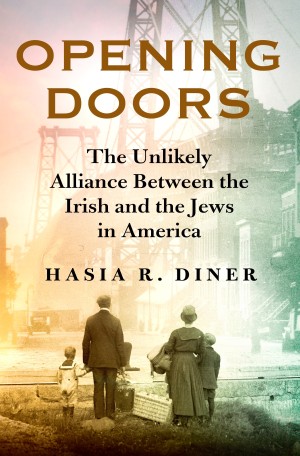A century or so ago, it was dangerous for Jewish American boys to walk through Irish neighborhoods on the way to and from school. The descendants of those kids would be pleasantly surprised to read the revisionist argument advanced by the dozen contributors to this illuminating volume. These scholars have identified not friction, but cooperation in the ways that Jewish and Irish immigrants — and their children and grandchildren — secured their places in American society. Indeed, Forged in America has uncovered a shared sense of marginality in a nation of Protestant hegemony.
Packed with surprises, this pioneering work of comparative scholarship in ethnic relations highlights many parallels between the two groups. Both, for instance, appealed to the victors of World War I at Versailles to gain national recognition, with the Irish seeking self-determination, and the Zionists, a homeland in Palestine. In addition, Lillian Wald spearheaded the fight for adequate public health on the Lower East Side, allying herself with uptown Jewish philanthropists. And Margaret Sanger took significant personal risks to give women access to birth control, in defiance of her own Church.
Coeditor Hasia R. Diner anchors this anthology with an exceptionally astute opening essay that emphasizes how historical and structural asymmetries kept the Irish and the Jews largely free from rivalry. Even when German Jewish immigration coincided with the Irish struggle to escape the famine, these newcomers occupied very different niches in the economy. One group was associated with construction work and domestic service, and the other, with the garment trades.
A generation or so later, when Eastern European Jews fled poverty and persecution, Tammany Hall and other male Irish American bosses provided Jews with transactional help in an effort to gain electoral support from new constituencies. Female Irish American public school teachers became for many Jewish children deft and even tender tutors, promoting middle-class values and fueling aspirations for success. Alfred E. Smith, a progressive New York governor, benefited from the counsel of Belle Moskowitz and Robert Moses. Another New York progressive, Paul O’Dwyer, defended the gunrunners who helped protect Israel at its founding, while a team of dedicated Jewish lawyers and publishers helped liberate James Joyce’s Ulysses from the grip of official censorship. From both minorities also came women who seized leadership in labor unions. It would seem, then, that the Irish and the Jews rarely got in each other’s way.
In Ireland, the Jewish population was too tiny for any significant encounters to occur. But in America, interactions proved mutually reinforcing in the expansion of democratic opportunity.
Stephen Whitfield is Professor of American Studies (Emeritus) at Brandeis University. He is the author of Learning on the Left: Political Profiles of Brandeis University (2020).





